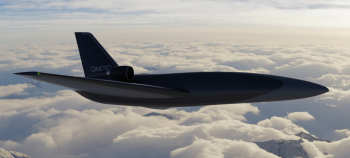It’s 2035 and fully autonomous systems are being deployed by British forces worldwide across domains in support of and alongside conventional forces. Operational doctrine and regulation has evolved to make humans and machines one coherent fighting force. That’s the vision of the Defence Drone Strategy at least, but with a decade to deliver this vision, it is still a huge undertaking.
The Defence Drone Strategy, how do you make the UK a world-leader in uncrewed defence systems?
23/02/2024
Ed Timpson, Head of Capability, Robotics and Autonomous Systems at QinetiQ

Uncrewed Systems and their employment have been accelerating at increasing pace over the past decade in defence. This trend has further accelerated with the conflict in Ukraine and tensions in the Red Sea highlighting to military leaders and governments how dual-use commercial/military technologies can deliver effects previously reserved for exquisite military equipment. Front line commands have been vigorously ‘doing stuff’ with uncrewed systems having varying levels of success, often with duplication. Now the Defence Drone Strategy is an attempt to wrestle industry and government into achieving the operational advantages promised by uncrewed systems.
The four key objectives outlined in the strategy aim to define a blueprint for pace, removing barriers and developing ‘secure by design’ systems in the UK, drawing upon the extensive research and development portfolio.
So, what does the strategy say?
The strategy is based on four key objectives:
- Expedite acquisition reform – this is about changing the way that we procure and roll-out new technologies to get them into the hands of the user as soon as possible; keeping a constant watch on developing threats and opportunities and responding at pace with new innovation and iterative updates to capability in the field, and enshrining the principle of spiral development.Traditional procurement approaches will not meet the needs of the warfighter, and we must adopt something more akin to an Urgent Capability Requirement approach.
- Build a resilient industrial base – any nation can only hope to deliver new technology at pace if they have a hardened supply chain to produce the key components needed. We agree entirely that to achieve the vision we must have a UK sovereign capability and on-shore design and production, helping to sustain competitive advantage and minimise supply chain risk. We should also ensure that barriers are reduced for small-and-medium-sized enterprises to engage with the defence market and bring knowledge and expertise from adjacent industries.
- Define digital architectures for seamless operational integration – drones can operate in the most contested spaces that would put human lives in danger, however, they need to operate collaboratively and seamlessly as part of an open architecture with crewed platforms and operations centres of our own and as well as those of our allies. We absolutely must be able to ensure secure interoperability to achieve operational mass and use real-world data to inform capability changes and technology innovation.
- Foster a culture of innovation – we absolutely agree that innovation is essential in keeping pace with adversaries and with the changing pace of the world at large. We must exploit technology at the leading edge by pursuing culture change within the Ministry of Defence itself, to harness its people but also working with industry to adapt existing infrastructure and estate to meet rapid research and development needs. Explicitly learning through allied partnerships such as the AUKUS trilateral agreement and working with authorities to navigate challenges in rapid innovation and testing will also be key. We also agree that the Civil Aviation Authority and Military Aviation Authority must be involved from the outset to ensure that we can meet regulatory challenges and that we can safely test and experiment with new technologies.

The strategy focusses on the development of these areas in line with the delivery of the Ukraine-UK uncrewed systems initiative. This allows lessons to be learnt from the frontline and innovation at pace to be delivered right to the warfighter, when it is needed the most. Alongside this, a governance framework for pan-domain delivery is being established to allow a clearer and more consistent interface for industry partners to collaborate with the defence industry.
What does this mean for industry?
Overall the Defence Drone Strategy is a huge step in the right direction, but pace is the challenge. Pace of technology adoption, Pace of procurement, Pace of getting capability into the hands of our warfighters. Increased collaboration, engagement and transparency with industry is the foundation that will enable this Defence Drone Strategy to deliver, and this has now been recognised. Industry must lean in and collaborate accordingly, breaking down existing barriers and delivering the vision laid out in this strategy for UK defence as a whole.
"Coming together is a beginning, staying together is progress, and working together is success." – Henry Ford

